Avery’s Rest
Located in present day Sussex County, near the 17th century frontier Dutch settlement of Whorekill (present-day Lewes) (see map below), Avery’s Rest represents one of the earliest colonial settlements professionally excavated in Delaware.
Non-native occupation at this site began at least by the mid-17th century, when a 300-acre land grant for “Avery’s Rest” was issued in 1666 to Captain John Avery, a mariner for the colony of Maryland who transported tobacco and food stores to Barbados and the West Indies. The full 800-acre tract was granted in 1674 when John Avery, his wife Sarah, and their three daughters moved onto the property (Sellers, 1901).
The Averys’ arrival followed the burning of the Whorekill settlement and surrounding farmsteads in December 1673, an act related to the final reclaiming of the territory by the English (de Valinger, 1950; Weslager, 1988; Weslager, 2016). After John Avery’s death in 1682, his wife remarried and his daughters engaged in a court dispute over ownership of the Avery’s Rest tract (Horle, 1991). The land was eventually partitioned between the daughters, one of whom lived at the site until 1715 (Horle, 1991).
The 11 graves found at the site could thus represent Avery family members, servants, enslaved individuals, or others living and laboring on the farmstead. To further elucidate their ancestry and identities, we conducted bioarchaeological and ancient DNA analyses of the human remains disinterred from the site.
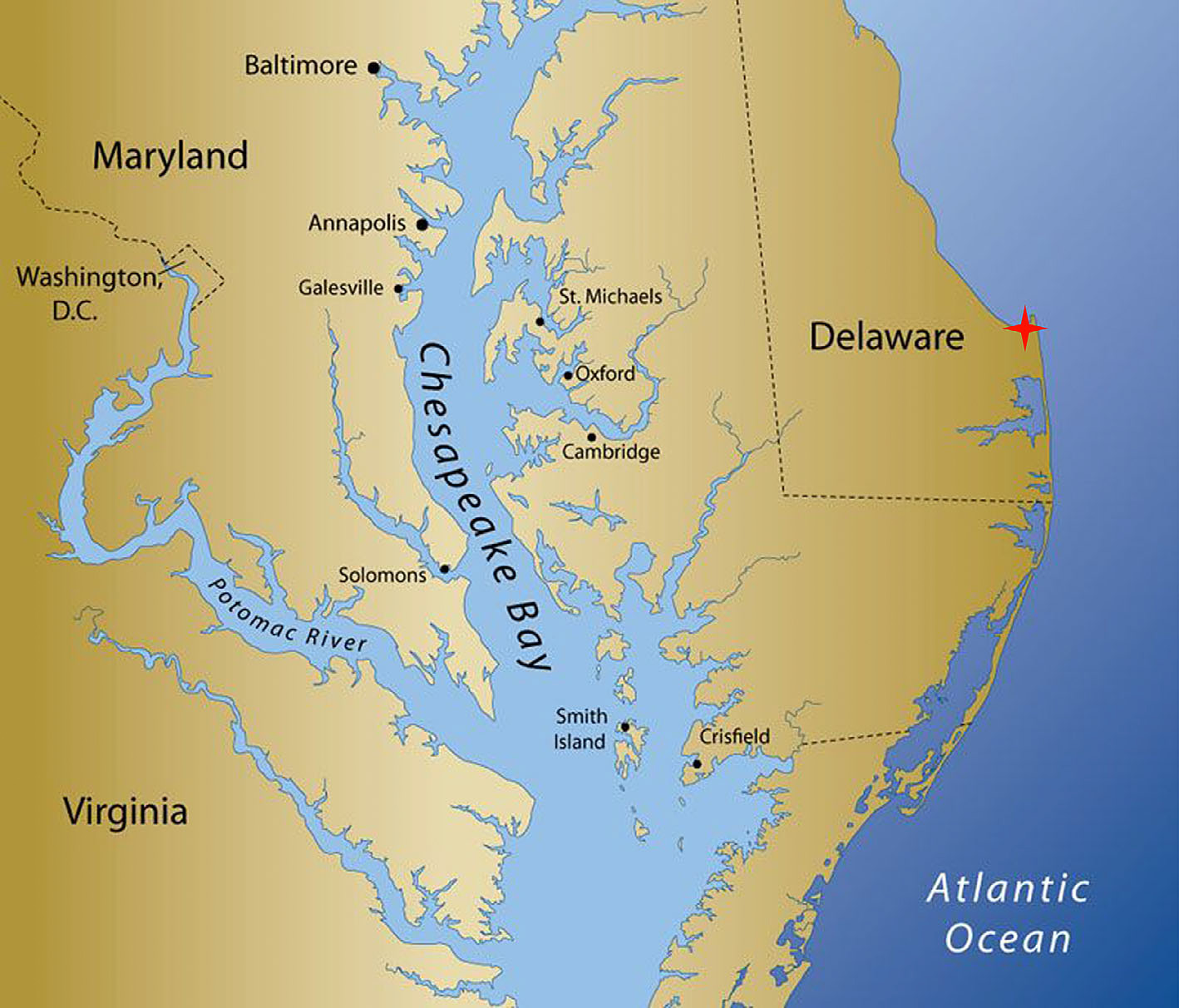
Map of Delaware within North America
Avery’s Rest archaeological site is marked with a star. Map provided by americanhistory.si.edu.
Explain the layout of the burials and initial assessment of biological ancestry based on skeletal analysis. Burials AR01-AR08 were thought to be persons of European ancestry, whereas burials AR09-AR11 were thought to be persons of African ancestry.
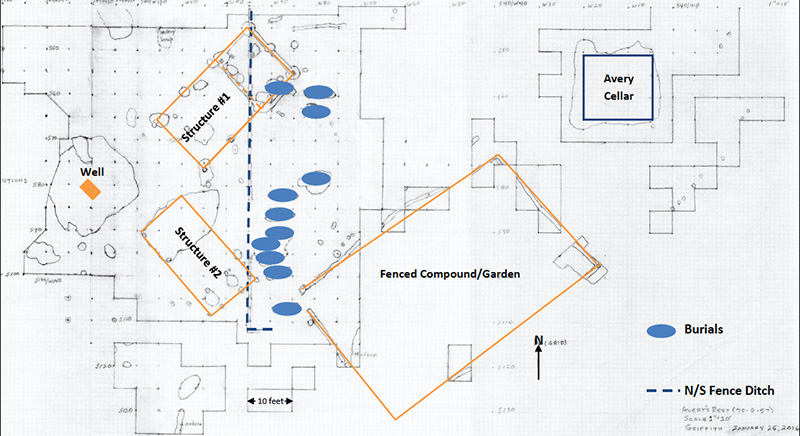
Site Map of the Avery’s Rest Archaeological Site
The map displays post holes, structures, a well, fence ditches, refuse features, and burials. Burials AR01–AR08 are located in the southern burial cluster and AR09–AR11 in the northern burial cluster. Image source: Dan Griffith.
A well-preserved bone from each skeleton was selected for mtDNA analysis. Extraction and sequencing of mtDNA was performed for all 11 skeletons, using appropriate protocols to prevent contamination with modern DNA. The entire control region (CR) of the mtDNA was obtained for these individuals, and the haplogroups to which they belonged ascertained through comparison with reference databases for European and African populations.
The mtDNA data confirmed the osteological assessments of geographical ancestry and identified European and African haplotypes in the Avery’s Rest individuals. The mtDNAs from the eight individuals in the southern burial cluster belonged to five different European haplotypes (W4a1, H24, H1af, T, and U5b2a1a), with four individuals (two females, one male, and one infant) sharing the same H1af haplotype. The three individuals from the northern burial cluster had three different African haplotypes (L3e3, L3i2, and L0a1a).
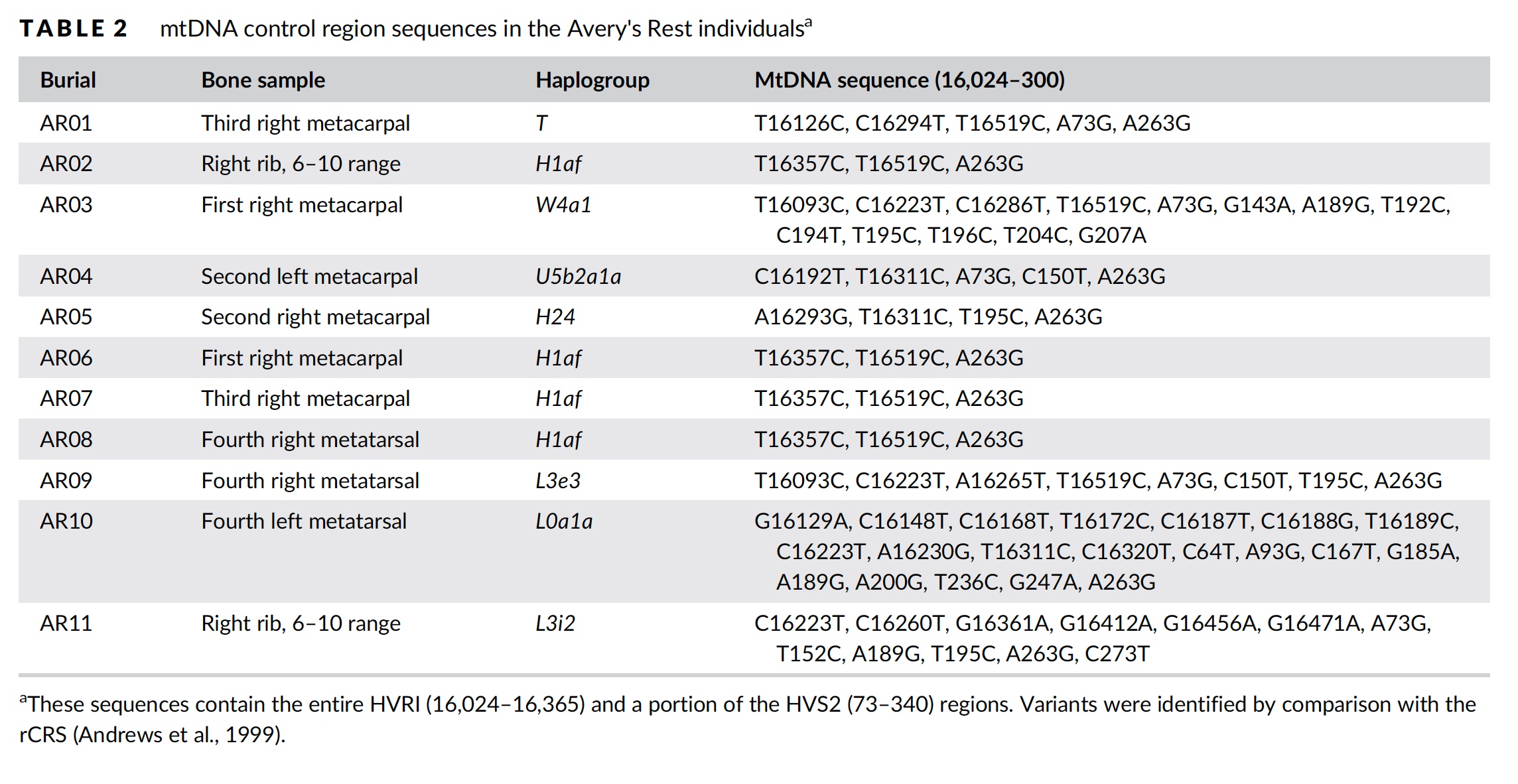
mtDNA Control Region Sequences in Avery’s Rest Individuals
Along with the bioarchaeological and documentary evidence, these initial aDNA findings contribute to our understanding of life on the colonial Delaware frontier. Evidence of maternal relatedness among European-descended individuals at the site demonstrates kin-based settlements in 17th century Delaware and provides preliminary identifications of individuals. The maternal genetic diversity of the individuals with African descent aligns with the routes of the trans-Atlantic slave trade but broadens our understanding of the ancestries of persons involved in it. Burial positioning, osteological pathology, and lack of maternal kinship among individuals of African descent provide tangible evidence for the emergence of racialized labor and society in Delaware during the late 17th century.
We have now completed the analysis of genomic variation in the Avery’s Rest individuals. The results of this analysis shed light on the population dynamics of an early colonial frontier settlement, with European individuals representing multi-generational kin interred next to individuals with diverse African ancestries that include a father-son pair. These findings highlight the diversity of persons, both kin and non-kin, present in early colonial frontier settlements, and the extent of geographic ruptures experienced by those forcibly enslaved at the incipience of the trans-Atlantic slave trade in North America.
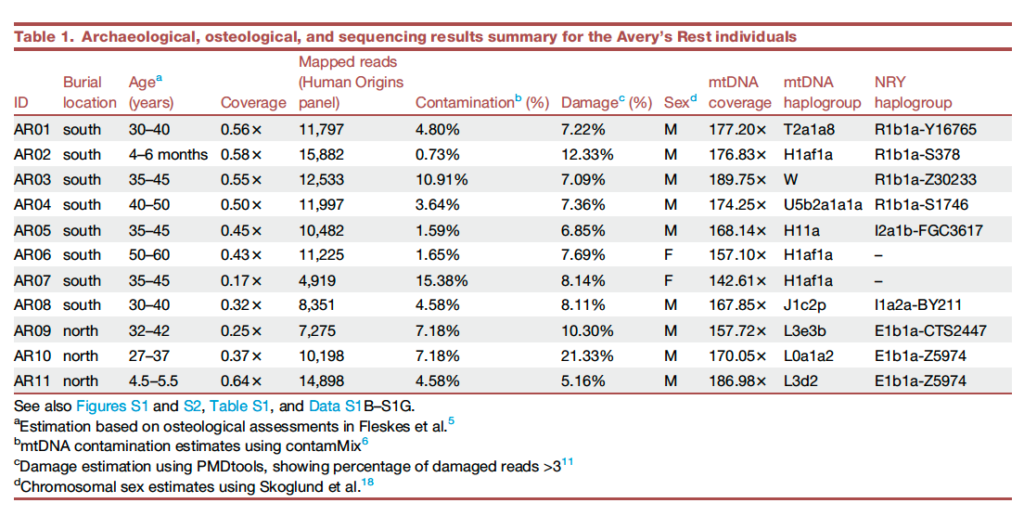
Archaeological, osteological and DNA sequencing results summary for the Avery’s Rest Individuals
Explain the results in table
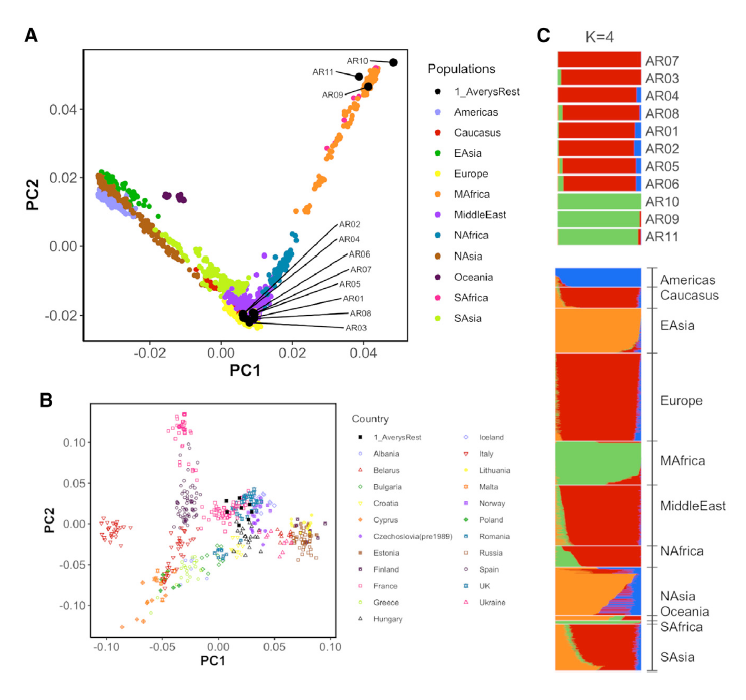
Genomic ancestries of Avery’s Rest individuals against the global Human Origins panel
(A) PCA results showing separation of individuals with European and African ancestry, respectively. (B) PCA results for the eight European-affiliated Avery’s Rest individuals, plotted against European populations in the Human Origins panel. (C) ADMIXTURE results at K=8 for the Avery’s Rest series.
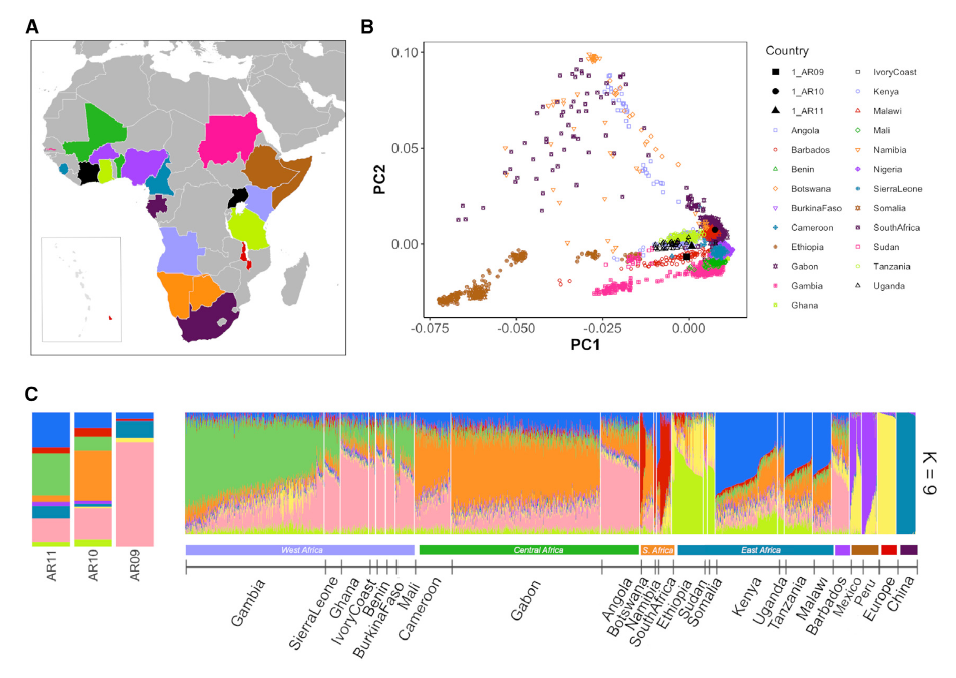
African ancestry profiles for AR09, AR10, and AR11 against a custom African reference panel
(A) Map of Africa with the countries used in the reference panel colored according to the accompanying PCA plot. The subpanel displays the Lesser Antilles islands, for which the island of Barbados is highlighted. (B) PCA plot of the three Avery’s Rest individuals with African ancestry. (C) ADMIXTURE profiles of the three individuals with African ancestry at K=9.
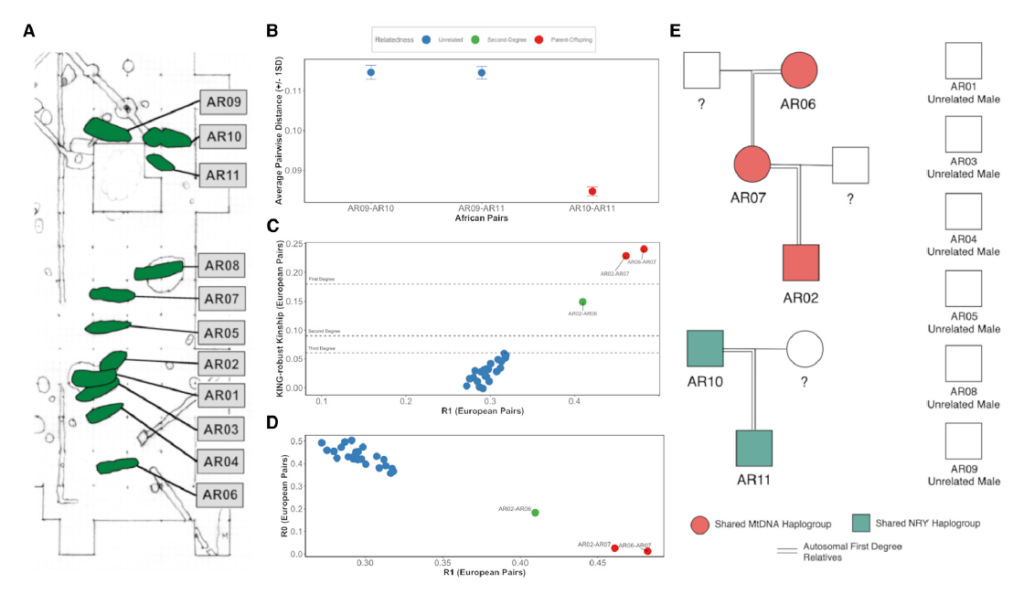
Kinship Estimation for the Avery’s Rest Individuals
(A) Burial locations at the Avery’s Reset site. Individuals AR01-AR08 are located in the southern burial cluster; individuals AR09-AR11 are located in the northern burial cluster. The space between the dots represents a 5-foot scale. Note that, due to the scale of the map, burials AR01 and AR03 appear to overlap but are, in fact, buried parallel to each other. (B) READ results for the African individuals, with error bars showing one standard error for average pairwise differences. (C and D) NgsRelate results for the 2DSFS method, displaying R1 and the KING-Coefficient and (D) R1 and the R0 values for the European-affiliated individuals. (E) Constructed pedigree chart showing relationships among Avery’s Rest individuals. Squares indicate males and circles represent females, based on chromosomal sex estimation.
Summary of Avery’s Rest Genomic Analysis
Our findings at the Avery’s Rest site illustrate how the entangled web of colonialism spans the larger Atlantic world and provide important insights into early colonial settlement, kinship, and the trans-Atlantic slave trade in Delaware at the end of the 17th century. This case study provides the first genomic evidence of the demographic makeup of European colonial migrants and their occupation in Delaware during the 17th century, which had previously only been estimated from archival records and archaeological evidence. Our results show the European-descended individuals were most genetically similar to populations from Great Britain and France, which correlates with historical records showing British colonial settlement in Delaware following Dutch occupation of Indigenous lands. Five non-genetically related males were buried along with three consecutive generations of matrilineal kin, representing a grandmother, mother, and son. This demographic profile supports historiographical findings of a blended or mosaic organizational structure for European colonists at early colonial Chesapeake and Mid-Atlantic settlements, in which unrelated males and small groups of biological kin formed social and labor units.
Besides providing insight into the demography of colonial Delaware, the identification of individuals of European and African ancestry at Avery’s Rest reflects mortuary practices in North American frontier settings. These individuals were interred in closely spaced, but separate, burial clusters divided by continental-level ancestry. Their interment location further suggests that interactions between European and African persons may have been more integrated than suggested by mortuary practices in later antebellum cemeteries, where burials were often interred in more separated locations based on race. The distinct clustering of the burial ground by continental ancestry nevertheless suggests that frontier lifeways from the beginning was governed by settler-colonial practices of racialized enslavement.
Acknowledgments
Thanks to the Avery Family representatives, property owners Mr. and Mrs. Waymon Harmon, the Delaware Division of Historical and Cultural Affairs, and the Archaeological Society of Delaware, Inc., for their support of this project. We also thank the Smithsonian Institution Collections Advisory Committee for granting permission to undertake this follow-up study. With respect to genomic analyses, we thank Dr. C.E.G. Amorim and Dr. Brenna Henn for access to the UC Davis HCLP Computing Server; Dr. Jonathan Schug at the Next Generation Sequencing Core at the University of Pennsylvania; and Joe May from the Division of Biology Sequencing Facility and Veronica Brown at the Genomics Core (UTK-Knoxville). ThDr. Barbara Health (UT-Knoxville) and Dr. Morgan Hoke (University of North Carolina, Chapel Hill) for their comments on drafts of the Current Biology paper.
Funding Support
This project was funded by National Science Foundation Doctoral Dissertation Research Improvement Grant (BCS-1825583, R.E.F and T.G.S.), SBE Postdoctoral Research Fellowship (SPRF-FR 2105384, R.E.F.), National Geographic Society grant (HJ-056ER-17, R.E.F.), Dissertation Completion Fellowship from the University of Pennsylvania (R.E.F), and the Penn Museum of Anthropology and Archaeology (R.E.F). The Rice Family Endowment for Forensic Anthropology provided critical support for Smithsonian Skeletal Biology Program contributions.
Ethics Statement
Consultation with representatives of Avery family descendants, the Harmon Family, who are the current property owners of the Avery’s Rest site, and the Delaware Division of Historical and Cultural Affairs were conducted. Permission was obtained from the Smithsonian Institution National Museum of Natural History Department of Anthropology Collections Advisory Committee for DNA sampling in 2019. Outreach programming and public presentations were conducted through the Delaware Division of Historical and Cultural Affairs, as well as The Delaware Archaeological Society, Inc.
Publications
Fleskes RE, Bruwelheide KS, West FL, Owsley DW, Griffith DR, Barca KG, Cabana GS, Schurr TG. 2019. Ancient DNA and bioarchaeological perspectives on European and African diversity and relationships on the colonial Delaware frontier. Am J Phys Anthropol 170(2):232-245. Epub 2019 Jul 4. Link
Fleskes RE, Schurr TG. 2022. Initial ancient DNA investigations at Avery’s Rest: Update and Prospects. The Bulletin of the Archaeological Society of Delaware, No. 59 New Series. Dover: Archaeological Society of Delaware, pp. 119-142.
Fleskes RE, Owsley DW, Cabana GS, Bruwelheide KS, Barc KG, Griffith DR, Schurr TG. 2023. Historic genomes elucidate European settlement and African diaspora in Delaware. Curr Biol 33: 1–8. Link
Laboratory of Molecular Anthropology
University of Pennsylvania
421 University Museum
3260 South Street
Philadelphia, PA 19104-6398
Tel: 215-573-2656

FOLOW US:
